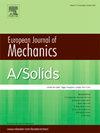金字塔堆积负刚度元结构的可调能量吸收
IF 4.2
2区 工程技术
Q1 MECHANICS
引用次数: 0
摘要
负刚度(NS)元结构提供了一种新的能量吸收机制。本文提出了一种金字塔堆积的负刚度(PNS)元结构,以实现能量吸收的可调性和微观水平的提高。采用有限元法分析了PNS超结构的吸能特性。通过准静态加载试验验证了有限元模型的准确性。PNS元结构单元胞的变形模式可以随着顶点高度的增加而从对称向反对称转变,这一点通过自振模态和压缩实验得到了验证。金字塔叠层设计显著提高了传统NS弯曲梁结构的吸能能力,对称和非对称耦合变形模式下的吸能分别提高了14.6%和21.2%。通过变形模式和参数分析,发现了多个控制变形序列,并对PNS元结构进行了合理布局的能量吸收调节。最后,采用塞子和梯度设计策略来调节和提高吸能效率,减小平台力波动。本文章由计算机程序翻译,如有差异,请以英文原文为准。
Tunable energy absorption of pyramid-stacked negative stiffness metastructure
Negative stiffness (NS) metastructures provide a new mechanism for energy absorption. This work proposes a pyramid-stacked negative stiffness (PNS) metastructure to achieve energy absorption tunability and improvement in micro level. The finite element method (FEM) is employed to analyze the energy absorption characteristics of PNS metastructures. The accuracy of the FE model is validated through the quasi-static loading experiment. The deformation pattern of the unit cell of PNS metastructure can be tuned from symmetric to anti-symmetric with increasing apex height, which is verified by natural vibration modes and compression experiments. The pyramid-stacked design significantly enhances the energy absorption capacity of conventional NS curved beam structures, exhibiting 14.6 % and 21.2 % improvements in energy absorption under coupled symmetric and anti-symmetric deformation patterns, respectively. Through deformation pattern and parametric analysis, multiple controlled deformation sequences are found and energy absorption is tuned in PNS metastructures with rational layouts. Finally, the strategies of stopper and gradient designs are used to tune and enhance the energy absorption efficiency and reduce the plateau force fluctuation.
求助全文
通过发布文献求助,成功后即可免费获取论文全文。
去求助
来源期刊
CiteScore
7.00
自引率
7.30%
发文量
275
审稿时长
48 days
期刊介绍:
The European Journal of Mechanics endash; A/Solids continues to publish articles in English in all areas of Solid Mechanics from the physical and mathematical basis to materials engineering, technological applications and methods of modern computational mechanics, both pure and applied research.

 求助内容:
求助内容: 应助结果提醒方式:
应助结果提醒方式:


